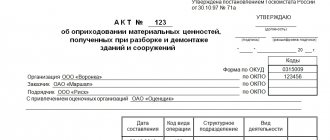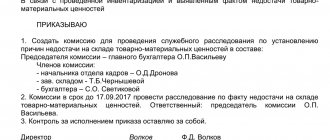An act of refusal to familiarize yourself with the order is drawn up by the personnel department in controversial cases related to labor legislation. By drawing up this document on time and according to the rules, you can protect yourself (the organization) from more troubles in possible legal proceedings.
FILES
Such papers are not an ordinary event. They are a tangible signal of very complex relationships in a team or between an organization and an individual employee.
It is worth noting that when going to court, labor disputes take place in civil cases. And in them all doubts will be interpreted in favor of the accuser, that is, the employee.
Especially if the issue of a “little man” who is “offended” by an entire company is being considered. Therefore, the company needs to play it safe and act carefully and strictly within the framework of the labor code. This is done in case, during the proceedings, the employee declares that the specified information was not communicated to him or was not presented in the required form.
What is stated in the act
If an employee does not want to sign or, in principle, does not intend to get acquainted with the contents of the order, notification, instruction, order or instruction, then a special paper is drawn up about this. It should contain:
- Full name and position of the employee who refuses to familiarize himself with the order (or put his signature on the documents);
- Full name of the person drawing up the document (often this is a personnel department employee, accountant or other official responsible for familiarizing employees with orders);
- positions, surnames, first names and patronymics of employees who will attest to the fact of categorical refusal (at least three people);
- place and date of compilation;
- name of company;
- if possible, exact time;
- number and date of the document due to which the dispute occurred;
- personal signatures of the persons who witnessed the act.
Also in the above form there are several blank lines to explain the motivation of the employee who refused. If the reasons were not given, then a dash is placed in these columns. If they were expressed at least orally, then these justifications can be written down by the document compiler who heard them.
If the employee has read the provided paper, but has not put the required reading mark, this act is also drawn up.
How to draw up a deed of refusal to sign in 2020
The responsible person has every right to independently choose the method of filling out the document.
This can be either a computer type or a handwritten version. After all the information has been provided, it is highly advisable to obtain a signature from the employee himself. In fact, with his autograph he confirms that the document contains reliable information. But in practice things are different. One can guess that such a refusal is an extraordinary situation. This suggests that there are certain problems in the relationship between management and employees. If this is indeed the case, then you should not count on the signature of the employee in respect of whom the document is being drawn up. Usually it is issued without his autograph. After all, here an important role is played by witnesses who are ready to confirm that the information was conveyed to the employee.
What is stated in the act
In general, the compiler has the right to decide for himself what information needs to be indicated in the document. If necessary, you can write down any information related to this situation here. However, there is certain information that can be called mandatory under any circumstances. These include:
- title with a brief reflection of the essence of the document;
- date and place of filling, it is highly desirable to additionally indicate the exact time;
- information about the company where this situation arose;
- information about the order that the employee did not want to get acquainted with. Its number and date of registration are noted;
- position and full name of the employee;
- information about the employee responsible for preparing this document;
- The members of the control group who act as witnesses in this procedure are listed. Each interested person must sign an autograph with a transcript opposite his/her name. Only in this case will the document be considered correctly executed.
If we are talking about a template that is specially created in an organization, then it is recommended to leave blank lines here. They are intended for the employee to indicate here the explanations for his actions. But the employee does not always make contact; accordingly, he may not give these testimonies. In this case, empty lines are filled with a dash. Sometimes an employee refuses to report the reasons in writing, but voices them orally. In this case, the author of the document writes explanations personally. But it is indicated that the explanations were recorded from the words of the employee.
In what situations is it issued?
There are times when an employee wants to go to court to protect his rights. If his main motivation is that he was not familiar with the order of the head of the company, then the act of refusing to familiarize himself with the order will be a compelling argument for the court to make a decision not in his favor.
There are also situations when an employee is physically unable to sign as a sign of agreement with any instructions. But this happens quite rarely. And in this case, references and notes about this fact are included in the text of the paper.
In the vast majority of cases, acts of refusal to familiarize themselves with the order are drawn up due to orders for disciplinary action against the employee or his dismissal. In any case, the document is a harbinger of an unpleasant situation. Often it precedes the end of an employee’s career in a particular organization or goes hand in hand with it.
What an employee can and should do
The rights and obligations of employees are prescribed in the Labor Code of the Russian Federation. According to it - or more precisely Article 21 - every employee has the right:
- to conclude an employment contract;
- its termination;
- changing the terms of the contract;
- provision of work;
- provision of a workplace in accordance with the standards of current legislation;
- full payment of the salary established in the employment contract;
- paid vacation;
- rest during the working day;
- creation of labor associations;
- participation in the management of the organization;
- conclusion of contracts related to labor activities;
- protection of your rights;
- conflict resolution during interaction with team members;
- strike;
- compensation for moral and physical harm caused during work.
Also see “Rights of Probationary Employees.”
Responsibilities are as follows:
- fulfillment of the terms of the employment contract;
- following a routine;
- follow the rules of law;
- do not damage property located in the access zone;
- warn about possible danger to the life and health of team members.
We invite you to familiarize yourself with the Waiver of ownership of real estate
Compilation rules
When filling out, it is fundamentally important to take into account the timing. The more accurately the time is specified, the better. In court, questions will be asked regarding time periods and testimony will be compared. It is also advisable to mention in the text where the order was read (office, HR office, manager’s office, etc.).
It is acceptable to ask the question orally or read the document out loud to the employee. The main thing is that the refusal is clear. The text of the act may sound like this:
“I, the head of the HR department, Vasily Ivanovich Tarasov, in the presence of the cleaner Elena Vitalievna Markova and the manager Ivan Sergeevich Knyazev, have drawn up this act stating that...”
Employees or persons who agreed to record the fact of refusal must also be present in this room and clearly understand that the employee refused to read the order and sign on it. Witnesses must sign to confirm this fact. Only in this case will the act have legal force. If the employee refused to sign this document, then this can be written at the very end of the act. There is no need to draw up a separate document regarding refusal to sign.
Why do they write orders{q}
There are several situations in which issuing an order is a necessary measure. The same applies to the need to familiarize yourself with the document with some other employees. Here are just a few relevant circumstances:
- When the internal routine changes.
- Application of disciplinary sanctions of any kind.
- For external transfers to other employers.
- Internal transfers to other workplaces.
- Involvement in overtime types of obligations.
- Dismissal of subordinates, regardless of the reason.
- Determining the order in which vacations are granted.
The familiarization procedure becomes a familiar and quick affair if a familiar environment develops at the enterprise. Special meetings are held or documents are provided on an individual basis. Difficulties arise for companies if there is a conflict of interest.
Specific example and wording
Suppose an employee should be fired due to absenteeism. But he refuses to sign any documents. In this case, you need to draw up a memo, fill out an absenteeism report (failure to show up for work), try to get an explanatory note (or draw up an act of refusal to draw it up), and issue a dismissal order. And only if the employee does not familiarize himself with the dismissal order (expressing this at least verbally), then a certificate of refusal to familiarize himself with the order is filled out.
An arbitrary form of compiling this paper is also acceptable, but it must contain all the above-mentioned information and details.
Thus, the form and sample provided for downloading are a good help for the personnel worker. There is no need to reinvent the wheel with them. Simply fill in the empty columns that describe the “actors” and the current situation. In this case, you must strictly adhere to the deadlines provided for by labor legislation.
Attention! One person is not enough to draw up an act. You need at least two signatures of witnesses who are not interested in the outcome of the case (plus the compiler, that is, three in total).
The same filling out rules apply in case of refusal to receive a work book upon dismissal, familiarization with the vacation schedule, etc.
Why is a signature required?
The first document required for employment is a contract, but to implement the agreements reached, an order from the director will be required. This document provides the basis for further actions by the internal services of the enterprise and applies to any changes, from hiring to dismissal.
Is it possible not to sign the order? Considering the situation from a legal point of view, it is more difficult to interpret the employee’s powers. In the provisions of Art. 21 of the Labor Code of the Russian Federation states that the list of employee responsibilities does not include signing an order of the enterprise. If an employee refuses to sign an order, the law cannot force the person to do so. Moreover, Art. 379 of the Labor Code, reluctance to sign a document is recognized as self-defense of the employee. Forced familiarization with the dismissal order is unacceptable. There is a need to record the fact of an attempt to familiarize a person with the paper, regardless of whether he agrees with the management’s decision.
The implementation of administration orders for dismissal in the absence of an employee’s signature is determined by Article 84.1 of the Labor Code of the Russian Federation. The legal norm provides for recording the fact of a person’s reluctance to sign the document in order to maintain the legitimacy of the dismissal process.
According to Art. 193 of the Labor Code of the Russian Federation, the enterprise must draw up an act, adhering to certain rules.
If an employee refuses to sign an order and there is no properly executed act, the director’s order is invalidated through the challenge procedure, and the employee is subject to reinstatement.
Additional rules for the procedure
One of the first steps when employees refuse to familiarize themselves with documents is to assemble special commissions, whose employees are informed about the current situation. The best option is for at least one of the following to be present on this commission:
- an ordinary employee;
- personnel officer;
- lawyer.
After this, a commission is assembled and an employee is invited. They show the order and ask you to sign as proof of familiarization.
Even if the other side continues to refuse, its position becomes more vulnerable. Witnesses appear who can confirm that the information has been communicated to the other party. At the next stage, the act itself is drawn up.











